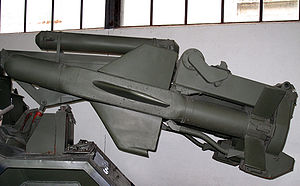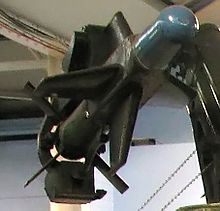- Malkara (missile)
-
Malkara 
Malkara on display at Saumur Armour MuseumType Anti-tank guided missile Place of origin  United Kingdom,
United Kingdom,
 Australia
AustraliaService history In service 1958 to 1960s Used by  United Kingdom
United KingdomProduction history Designer Royal Aircraft Establishment/Aeronautical Research Laboratory Designed 1954 Number built 1,000 Variants none Specifications Weight 93.5 kg (206 lb) Length 1.9 m (6 ft 3 in) Diameter 203 mm (8.0 in) Warhead 26 kg (57 lb) HESH Detonation
mechanismimpact Engine solid rocket Wingspan 80 cm (2 ft 7 in) Operational
range4,000 metres (2.5 mi) Flight ceiling n/a Guidance
systemwire guided line of sight Steering
systemcontrol surfaces Launch
platformVehicle The Malkara missile (from an Aboriginal word for "shield") was one of the earliest anti-tank guided missiles (ATGMs). It was jointly developed by Australia and the United Kingdom between 1951 and 1954, and was in service from 1958 until gradually replaced by the Swingfire missile in the late 1960s. It was intended to be light enough to deploy with airborne forces, yet powerful enough to knock out any tank then in service.
Contents
Development and operations
The concept of the Malkara was probably inspired by the WWII German X-7 anti-tank missile.[citation needed] Design was principally undertaken at the Australian Government Aeronautical Research Laboratory, and this phase was also one of the first examples of computer simulation in engineering design. Development testing was carried out at Woomera Prohibited Area, and approval testing at the tank training range at Lulworth Cove, Dorset. Although testing at Dorset apparently achieved an impressive 90% Pkill, in service the missiles were not considered a great success, due to three principal failures:
- They were considered too heavy. As they were too heavy for manpacking, they could only be operated from their specialist vehicles, reducing flexibility; and
- Accuracy achieved in practice was poor. This may have been because the awkward control system required a lot of practice, and there was neither a simulation system nor sufficient missiles for practice firing. In their memoirs, some operators state that they only fired one missile in their careers.
- Finally, their speed was low, with almost 30 secs to the maximum range
However, lessons learned from the Malkara project led to improvements in later programs. In addition, the basic airframe and expertise were directly used in the development of the Ikara anti-submarine missile and the Sea Cat surface-to-air missile.
Malkara was unusual amongst anti-tank missiles in that it had a High Explosive Squash Head (HESH), also known as High Explosive Plastic (HEP), warhead instead of the more usual shaped charge HEAT (High Explosive Anti Tank) warhead. The United Kingdom always showed interest for HESH, the main explosive-based anti-tank ammunition in British use including tanks like the Centurion. A 26/27 kg anti-tank warhead was well above the average, but Malkara had a caliber of 203 mm (8.0 in).
Operators
Specifications
- Length: 1.9 m (6.3 ft)
- Diameter: 200 mm (8 in)
- Wingspan: 800 mm (2.6 ft)
- Range: 4,000 m (4400 yd)
- Propulsion: Dual thrust solid rocket
- Speed: 146.19 m/s (327 mph) - low-subsonic, 28 sec to 4 km max range
- Overall weight: 93.5 kg (206 lb)
- Warhead: 26 kg (57 lb) HESH
- Guidance: Wire guided MCLOS, using a thumb joystick and visual observation of two flares on the wings.
- Number built: 1000
See also
- Humber Hornet
Notes
References
- War Machine encyclopedia, Aerospace Publishing Ltd., pag. 253 (in Italian version printed by De Agostini, 1984).
- Rockets and Missiles - John W. R. Taylor - Hippo Books No 8 - Hamlyn, 1971 - ISBN 0-0600-37528-5
External links
Guided missiles of the United Kingdom Air-to-air Air-to-surface Surface-to-air Bloodhound · Blowpipe · Javelin · Rapier · Sea Cat · Sea Dart · Sea Slug · Sea Viper · Sea Wolf · Starburst · Starstreak · Tigercat · Thunderbird
Surface-to-surface Nuclear Blue Steel · Blue Streak · Blue Water · Green Cheese
1 Anglo-French 2 Anglo-Australian Categories:- Anti-tank missiles of Australia
- Anti-tank missiles of the United Kingdom
Wikimedia Foundation. 2010.


